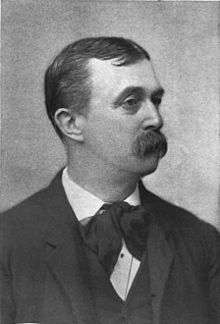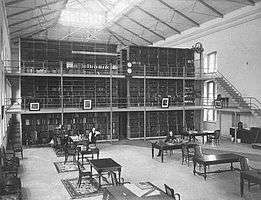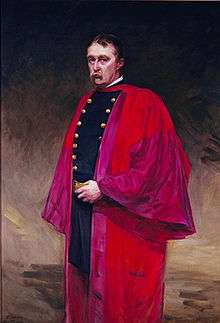John Shaw Billings
| John Shaw Billings | |
|---|---|
 John Shaw Billings ca. 1896 | |
| Born |
April 12, 1838 Allensville, Switzerland County, Indiana |
| Died |
March 11, 1913 (aged 74) New York City |
| Education | Miami University, Medical College of Ohio |
| Occupation | Librarian, surgeon |
| Spouse(s) | Kate M. Stevens |
| Children | Jessie Ingram, Kate Sherman, John Sedgwick, Mary Clure, Margaret Janeway |


John Shaw Billings (April 12, 1838 – March 11, 1913) was an American librarian, building designer, and surgeon.[1] However, he is best known as the modernizer of the Library of the Surgeon General's Office of the Army and as the first director of the New York Public Library. In his early years, he was a surgeon and a statistician on medicine in the U.S. Army. Billings oversaw the building of the Surgeon General's Library, the nation's first comprehensive library for medicine. Because of his innovative approaches to improving public health and hospitals, Billings headed the U.S. Census Bureau's division of Vital Statistics and oversaw statistical compilation of censuses. Along with Robert Fletcher, Billings started Index Medicus, a monthly guide to contemporary medicine that ran for 16 months until his retirement at the Medical Museum and Library.[2] He also served as Johns Hopkins Hospital's medical advisor and authored reports regarding criteria for medical and nursing curricula as well as hospital design. In addition to his work at Johns Hopkins Hospital, he was a hygiene faculty member at the University of Pennsylvania, the director at University Hospital, and the Chairman at the Carnegie Institution.
Biography
Early life
John Shaw Billings was born on April 12, 1838 in Allensville, Switzerland County in Indiana. In the century before, his father's family moved to Syracuse, New York after leaving England in 1654. His father was born in Saratoga, New York and was kin of William Billings. Billings' mother, Abby Shaw Billings, was born in Raynham, Massachusetts and was a direct blood relative of the Mayflower settlers. In 1843, Billings' family moved to Rhode Island but returned to Allensville, Indiana in 1848 due to the father's relocation of career as a postmaster.[3] During his childhood, Billings received education in both Providence, Rhode Island and Indiana. He inherited his mother's love for reading and learned Latin and Greek. Due to his love for learning and education, he agreed to renounce any inheritance if his father allowed him to attend college. In 1852, at the age of fourteen, Billings entered Miami University in Oxford, Ohio, which was approximately 50 miles from Switzerland Country.[4] Through his five years at the university, he spent most of his time reading in the library. In 1857, Billings graduated from Miami University second in his class and was admitted a year later to Cincinnati's Medical College of Ohio. Billings received his medical degree in 1860. His thesis on "The Surgical Treatment of Epilepsy" drew attention from the faculty as it provided accurate indications of the operations implemented at the time.
Early career
Settling in Cincinnati, Billings decided to continue surgical practice. Hoping to improve hospital service on the battlefield, he became the anatomy demonstrator at the Cincinnati's Medical College. However, in 1861, he declined an offer to become a surgeon assistant.[4] Instead in 1861, Billings went in for an examination for the regular army, becoming first of his class. However, no vacant spots were available in the regular corps, so he was appointed to be an assistant surgeon in Union Hospital in Georgetown. Because of his surgical skill and talent, he carried out most of the surgical work, holding the reputation for his skills in urethral strictures treatment.[4] The year after, on April 16, Billings was commissioned first lieutenant, and then took charge of Cliffburne Hospital's development in Georgetown as Union Hospital's operations relocated to Cliffburne. In August of that year, he was transferred to Satterlee General Hospital, a new hospital in West Philadelphia. After serving as the Executive Officer at the hospital for several months, he was directed to the Army of the Potomac in March 1863 and was assigned to Sykes' Division of Meade's Corps in the 11th Infantry.[4]
Late career
After the Civil War, Billings assumed direction of the Army Surgeon General's library from about 1867 to 1895.[5] During this time, Billings expanded the library from 2,300 to 124,000 volumes, making it the largest medical library in the Americas.[5] When Billings inherited the library, its contents were listed primarily by author and secondarily by subject.[5] Billings redesigned the catalog with author and subject indexes.[5] However, his catalog could not meet the demands of increased publications, so he created a separate indexing system for medical periodicals, which became known as the Index Medicus.[5]
Billings supervised the 1880 and 1890 U.S. Censuses and worked with the compilation of statistics. He played an important role as he introduced the punch-card system of calculating vital statistics with mechanical methods, which was then implemented into the 1890 census.
Billings received an Honorary Fellowship of the Royal College of Surgeons in Ireland in 1892.[4] He was elected a member of the American Antiquarian Society in 1899.[6] He was also elected an Associate Fellow of the American Academy of Arts and Sciences in 1912.
After he left the Surgeon General's Office, he united the libraries of New York to form the New York Public Library from 1896 to 1913. The punch-card system he introduced in the U.S. Censuses was further used in the New York Public Library construction. It was Billings who inspired Andrew Carnegie to provide $5 million for the construction of sixty-five branch libraries throughout New York and 2509 libraries in cities and towns across North America and Britain. During the library's construction, Billings directed the re-cataloging of the works from the Lenox, Tilden, and Astor Foundations, which were used to form the Library in 1895. Billings also recruited a young man named Harry Miller Lydenberg to work as his personal assistant and head of reference. Lydenberg expanded upon the collection practices of Billings, and eventually served as Director of NYPL from 1934-1941.[5]
Billings was the senior editor of books reporting the work of the Committee of Fifty to Investigate the Liquor Problem in the early 1900s. The Committee researched the activities and publications of the Department of Scientific Temperance Instruction of the Woman's Christian Temperance Union (WCTU).
Affiliation with Johns Hopkins University
Billings is renowned for his work of planning the construction of the Johns Hopkins University Hospital. He is credited with designing the original buildings of Johns Hopkins Hospital, which opened in 1889, as well as conducting the national and international search for the initial faculty for Johns Hopkins University. He drafted organization and construction plans for the hospital in 1873 and also recommended the construction pavilion plan, which soon became a plan utilized across the nation. Billings wrote numerous reports regarding the training of hospital staff and the organization of the hospital administration.[7]
In addition, Billings served as the primary advisor to Daniel Coit Gilman, in charge of engineering and implementing the initial educational infrastructure of Johns Hopkins School of Medicine. Although Billings' proposed medical curricula and partitioning of faculty into departments based on specialties were not unprecedented at that time, the establishment of Billing's framework laid the foundation for the resurgence of modern medical schools in the United States. [3]The building with the hospital's trademark dome was subsequently named for Billings. He played a significant role in the determination of the philosophy, structure, organization, and faculty of the Johns Hopkins Medical School.
Notable achievements
A senior surgeon in the war, Billings built the Library of the Surgeon General's Office (now the National Library of Medicine), the centerpiece of modern medical information systems.[8] Billings figured out how to analyze medical and demographic data mechanically by turning it into numbers and punching onto cardboard cards as developed by his assistant at the Census Bureau Herman Hollerith. This was the origin of the computer punch card system that dominated statistical data manipulation until the 1970s. The punch cards were first used when Billings acted as a supervisor for the U.S. Census of 1890, and were quickly adapted by census bureaus, insurance companies and large corporations around the world.[9] He came up with the idea for the library when working on his doctoral thesis when he discovered that there was not one library that had the resources needed for his research. To fix this, John Shaw Billings built a collection and also created Index-catalogues. By the time Billings retired from the army, he had already collected 116,847 books and 191,598 pamphlets.[3] This collection made up the National Library of Medicine and it has grown ever since.
Billings was known for his expertise in hospital construction since the Civil War. He played a significant role in designing the Johns Hopkins Hospital, making the plans and perfecting the layout perfect for teaching. Billings also helped plan the building of six other institutions, including another hospital.[3] He is recognized for the contributions he made to the U.S. Army. His successful organization of army hospitals set him up for a continuing career in hospital planning.[3] Despite many changes since opening in 1889, the main entrance of Johns Hopkins Hospital remains the same and is known as the Billing's Building.
Personal life
Billings married Kate M. Stevens on September 3, 1862 in St. John's Church, Georgetown (Washington, D.C.). They had five children. His wife died on August 19, 1912, which was a tremendous blow to Billings.[10] During the last several years of his life, he developed a cancer of the lip in 1890 and was diagnosed with bilary calculus, causing him to undergo operation for his cancer and for the removal of his gall bladder. On March 11, 1913, Billings died of pneumonia after an operation for urinary calculus at the age of 74 in New York City.[11] He was buried at Arlington National Cemetery with military honors.
His portrait,[12] painted by Cecilia Beaux, hangs in the Main Reading Room of the U.S. National Library of Medicine, where several collections of his papers are located.[13]
Works
Among his publications are:[14]
- "

- Billings, John (1884). The principles of ventilation and heating, and their practical application (PDF). New York: The Sanitary engineer. OL 20621328M. (NLM) 63110980R.
- Mortality and Vital Statistics of the United States (1885)
- Medical Museums" (1888) Online at Google Books[15]
- National Medical Dictionary (Two volumes, 1889)
- Billings, John (1890). Description of the Johns Hopkins Hospital. Baltimore: [Press of I. Friedenwald]. (NLM) 68110400R.
- Social Statistics of Cities (Six volumes, for the Eleventh Census)
- Billings, John (June 17, 1902). Some Library Problems of To-Morrow. American Library Association.
- Physiological Aspects of the Liquor Problem (1903)
See also
Notes
- ↑

- ↑ "Office of Medical History - Colonel John Shaw Billings". history.amedd.army.mil. Retrieved 2017-05-01.
- 1 2 3 4 "John Shaw Billings Centennial" (PDF). Retrieved 14 April 2017.
- 1 2 3 4 5 "John Shaw Billings facts, information, pictures | Encyclopedia.com articles about John Shaw Billings". www.encyclopedia.com. Retrieved 2017-05-01.
- 1 2 3 4 5 1967-, Forte, Eric J.,. Fundamentals of government information : mining, finding, evaluating, and using government resources. Hartnett, Cassandra J., 1964-, Sevetson, Andrea, (Second ed.). Chicago. ISBN 9780838913956. OCLC 1006879919.
- ↑ American Antiquarian Society Members Directory
- ↑ "John Shaw Billings | ASIS&T". www.asist.org. Retrieved 2017-05-01.
- ↑ James H. Cassedy, "Numbering the North's Medical Events: Humanitarianism and Science in Civil War Statistics," Bulletin of the History of Medicine, (1992) 66#2 pp 210-233
- ↑ Allen Kent; et al. (1975). Encyclopedia of Library and Information Science. CRC Press. p. 338.
- ↑ "John Shaw Billings | ASIS&T". www.asist.org. Retrieved 2017-05-03.
- ↑ Mitchell, S. (August 1917). "Biographical Memoir of John Shaw Billings" (PDF). Retrieved April 20, 2017.
- ↑ "Objects of Art: Colonel John Shaw Billings, M.D." U.S. National Library of Medicine. 2012-02-27. Retrieved 2013-05-30.
- ↑ "John Shaw Billings Papers 1841-1975". National Library of Medicine.
- ↑ Lydenberg (1924)
- ↑ French translation (1888): [John Shaw] Billings. "Les musées médicaux". La Revue scientifique, p. 594, at Google Books. Vol. 42. An editor of the Revue (see footnote) considers that American medical museums have become an example for France.
References
- Lydenberg, Harry Miller (1924). John Shaw Billings: Creator of the National Medical Library and its Catalogue, First Director of the New York Public Library. American Library Association.
- Garrison, Fielding H. (1915). John Shaw Billings: A Memoir. Putnam's.
- Hasse, Adelaide R. Bibliography of the Writings of John Shaw Billings, 1861-1913. (Garrison's Memoir, p. 411-422)
- Havighurst, Walter, Men of Old Miami, 1809-1873: A Book of Portraits, New York City: G.P. Putnam's Sons, 1974.
- Mitchell, S. (August 1917) "Biographical Memoir of John Shaw Billings." National Academy of Sciences of the United States of America. Retrieved April 20, 2017
- "John Shaw Billings." Encyclopedia of World Biography. Retrieved April 20, 2017.
- Phalen, James. (January 1942) "The Army Medical Bulletin, Number 60: Colonel John Shaw Billings." US Army Medical Department. Retrieved April 20, 2017.
- Chapman, Carleton (1994). Order out of chaos : John Shaw Billings and America's coming of age. Boston: Boston Medical Library in the Francis A. Countway Library of Medicine. ISBN 9780881351873. LCCN 94186079. OCLC 30480301. (NLM) 9435818.
- "John Shaw Billings Centennial." National Library of Medicine. Retrieved April 22, 2017.
- "John Shaw Billings." Association for Information Science and Technology. Retrieved April 22, 2017
External links
| Wikisource has original works written by or about: John Shaw Billings |
| Wikimedia Commons has media related to John Shaw Billings. |
- John Shaw Billings at Find a Grave
- National Academy of Sciences Biographical Memoir
- John Shaw Billings Correspondence Collection 1862-1912—National Library of Medicine finding aid
- John Shaw Billings Papers, in the Adjutant General's Office Records (RG 94) in the National Archives 1861-1895—National Library of Medicine finding aid
- John S. Billings correspondence in the New York Public Library 1866-1913—National Library of Medicine finding aid
- John S. Billings documents and letters in the National Archives 1861-1895—National Library of Medicine finding aid
- John Shaw Billings Correspondence with Libraries of the American Philosophical Society and the College of Physicians of Philadelphia Microfilm Copies 1878-1916—National Library of Medicine finding aid
- John Shaw Billings Papers at the University of South Carolina 1856-1966—National Library of Medicine finding aid
- John Shaw Billings Papers at New York Public Library [microform] 1854-1913—National Library of Medicine Finding aid
- John Shaw Billings: "I Could Lie Down and Sleep for Sixteen Hours without Stopping," Indiana Historical Bureau
- John Shaw Billings: The Many Lives He has Led, Indiana Historical Bureau